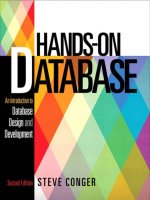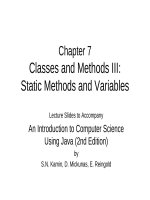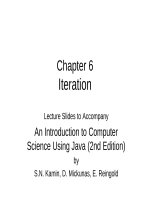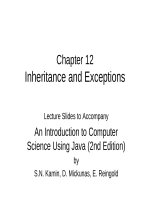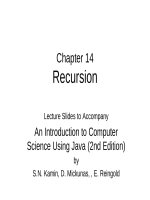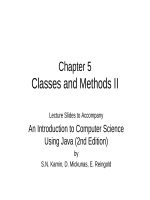an introduction to the analysis of algorithms 2nd edition
Bạn đang xem bản rút gọn của tài liệu. Xem và tải ngay bản đầy đủ của tài liệu tại đây (5.56 MB, 593 trang )
www.it-ebooks.info
AN INTRODUCTION
TO THE
ANALYSIS OF ALGORITHMS
Second Edition
www.it-ebooks.info
This page intentionally left blank
www.it-ebooks.info
AN INTRODUCTION
TO THE
ANALYSIS OF ALGORITHMS
Second Edition
Robert Sedgewick
Princeton University
Philippe Flajolet
INRIA Rocquencourt
Upper Saddle River, NJ • Boston • Indianapolis • San Francisco
New York • Toronto • Montreal • London • Munich • Paris • Madrid
Capetown • Sydney • Tokyo • Singapore • Mexico City
www.it-ebooks.info
Many of the designations used by manufacturers and sellers to distinguish their prod-
ucts are claimed as trademarks. Where those designations appear in this book, and
the publisher was aware of a trademark claim, the designations have been printed
with initial capital letters or in all capitals.
e authors and publisher have taken care in the preparation of this book, but make
no expressed or implied warranty of any kind and assume no responsibility for er-
rors or omissions. No liability is assumed for incidental or consequential damages in
connection with or arising out of the use of the information or programs contained
herein.
e publisher offers excellent discounts on this book when ordered in quantity for
bulk purchases or special sales, which may include electronic versions and/or custom
covers and content particular to your business, training goals, marketing focus, and
branding interests. For more information, please contact:
U.S. Corporate and Government Sales
(800) 382-3419
For sales outside the United States, please contact:
International Sales
Visit us on the Web: informit.com/aw
Library of Congress Control Number: 2012955493
Copyright
c
⃝ 2013 Pearson Education, Inc.
All rights reserved. Printed in the United States of America. is publication is
protected by copyright, and permission must be obtained from the publisher prior to
any prohibited reproduction, storage in a retrieval system, or transmission in any form
or by any means, electronic, mechanical, photocopying, recording, or likewise. To
obtain permission to use material from this work, please submit a written request to
Pearson Education, Inc., Permissions Department, One Lake Street, Upper Saddle
River, New Jersey 07458, or you may fax your request to (201) 236-3290.
ISBN-13: 978-0-321-90575-8
ISBN-10: 0-321-90575-X
Text printed in the United States on recycled paper at Courier in Westford, Massachusetts.
First printing, January 2013
www.it-ebooks.info
F O R E W O R D
P
EOPLE who analyze algorithms have double happiness. First of all they
experience the sheer beauty of elegant mathematical patterns that sur-
round elegant computational procedures. en they receive a practical payoff
when their theories make it possible to get other jobs done more quickly and
more economically.
Mathematical models have been a crucial inspiration for all scientic
activity, even though they are only approximate idealizations of real-world
phenomena. Inside a computer, such models are more relevant than ever be-
fore, because computer programs create articial worlds in which mathemat-
ical models often apply precisely. I think that’s why I got hooked on analysis
of algorithms when I was a graduate student, and why the subject has been
my main life’s work ever since.
Until recently, however, analysis of algorithms has largely remained the
preserve of graduate students and post-graduate researchers. Its concepts are
not really esoteric or difficult, but they are relatively new, so it has taken awhile
to sort out the best ways of learning them and using them.
Now, after more than 40 years of development, algorithmic analysis has
matured to the point where it is ready to take its place in the standard com-
puter science curriculum. e appearance of this long-awaited textbook by
Sedgewick and Flajolet is therefore most welcome. Its authors are not only
worldwide leaders of the eld, they also are masters of exposition. I am sure
that every serious computer scientist will nd this book rewarding in many
ways.
D. E. Knuth
www.it-ebooks.info
This page intentionally left blank
www.it-ebooks.info
P R E F A C E
T
HIS book is intended to be a thorough overview of the primary tech-
niques used in the mathematical analysis of algorithms. e material
covered draws from classical mathematical topics, including discrete mathe-
matics, elementary real analysis, and combinatorics, as well as from classical
computer science topics, including algorithms and data structures. e focus
is on “average-case” or “probabilistic” analysis, though the basic mathematical
tools required for “worst-case” or “complexity” analysis are covered as well.
We assume that the reader has some familiarity with basic concepts in
both computer science and real analysis. In a nutshell, the reader should be
able to both write programs and prove theorems. Otherwise, the book is
intended to be self-contained.
e book is meant to be used as a textbook in an upper-level course on
analysis of algorithms. It can also be used in a course in discrete mathematics
for computer scientists, since it covers basic techniques in discrete mathemat-
ics as well as combinatorics and basic properties of important discrete struc-
tures within a familiar context for computer science students. It is traditional
to have somewhat broader coverage in such courses, but many instructors may
nd the approach here to be a useful way to engage students in a substantial
portion of the material. e book also can be used to introduce students in
mathematics and applied mathematics to principles from computer science
related to algorithms and data structures.
Despite the large amount of literature on the mathematical analysis of
algorithms, basic information on methods and models in widespread use has
not been directly accessible to students and researchers in the eld. is book
aims to address this situation, bringing together a body of material intended
to provide readers with both an appreciation for the challenges of the eld and
the background needed to learn the advanced tools being developed to meet
these challenges. Supplemented by papers from the literature, the book can
serve as the basis for an introductory graduate course on the analysis of algo-
rithms, or as a reference or basis for self-study by researchers in mathematics
or computer science who want access to the literature in this eld.
Preparation. Mathematical maturity equivalent to one or two years’ study
at the college level is assumed. Basic courses in combinatorics and discrete
mathematics may provide useful background (and may overlap with some
www.it-ebooks.info
viii P
material in the book), as would courses in real analysis, numerical methods,
or elementary number theory. We draw on all of these areas, but summarize
the necessary material here, with reference to standard texts for people who
want more information.
Programming experience equivalent to one or two semesters’ study at
the college level, including elementary data structures, is assumed. We do
not dwell on programming and implementation issues, but algorithms and
data structures are the central object of our studies. Again, our treatment is
complete in the sense that we summarize basic information, with reference
to standard texts and primary sources.
Related books. Related texts include e Art of Computer Programming by
Knuth; Algorithms, Fourth Edition, by Sedgewick and Wayne; Introduction
to Algorithms by Cormen, Leiserson, Rivest, and Stein; and our own Analytic
Combinatorics. is book could be considered supplementary to each of these.
In spirit, this book is closest to the pioneering books by Knuth. Our fo-
cus is on mathematical techniques of analysis, though, whereas Knuth’s books
are broad and encyclopedic in scope, with properties of algorithms playing a
primary role and methods of analysis a secondary role. is book can serve as
basic preparation for the advanced results covered and referred to in Knuth’s
books. We also cover approaches and results in the analysis of algorithms that
have been developed since publication of Knuth’s books.
We also strive to keep the focus on covering algorithms of fundamen-
tal importance and interest, such as those described in Sedgewick’s Algorithms
(now in its fourth edition, coauthored by K. Wayne). at book surveys classic
algorithms for sorting and searching, and for processing graphs and strings.
Our emphasis is on mathematics needed to support scientic studies that can
serve as the basis of predicting performance of such algorithms and for com-
paring different algorithms on the basis of performance.
Cormen, Leiserson, Rivest, and Stein’s Introduction to Algorithms has
emerged as the standard textbook that provides access to the research litera-
ture on algorithm design. e book (and related literature) focuses on design
and the theory of algorithms, usually on the basis of worst-case performance
bounds. In this book, we complement this approach by focusing on the anal-
ysis of algorithms, especially on techniques that can be used as the basis for
scientic studies (as opposed to theoretical studies). Chapter 1 is devoted
entirely to developing this context.
www.it-ebooks.info
P ix
is book also lays the groundwork for our Analytic Combinatorics, a
general treatment that places the material here in a broader perspective and
develops advanced methods and models that can serve as the basis for new
research, not only in the analysis of algorithms but also in combinatorics and
scientic applications more broadly. A higher level of mathematical matu-
rity is assumed for that volume, perhaps at the senior or beginning graduate
student level. Of course, careful study of this book is adequate preparation.
It certainly has been our goal to make it sufficiently interesting that some
readers will be inspired to tackle more advanced material!
How to use this book. Readers of this book are likely to have rather diverse
backgrounds in discrete mathematics and computer science. With this in
mind, it is useful to be aware of the implicit structure of the book: nine chap-
ters in all, an introductory chapter followed by four chapters emphasizing
mathematical methods, then four chapters emphasizing combinatorial struc-
tures with applications in the analysis of algorithms, as follows:
ANALYSIS OF ALGORITHMS
RECURRENCE RELATIONS
GENERATING FUNCTIONS
ASYMPTOTIC APPROXIMATIONS
ANALYTIC COMBINATORICS
TREES
PERMUTATIONS
STRINGS AND TRIES
WORDS AND MAPPINGS
INTRODUCTION
D
ISCRETE MATHEMATICAL METHODS
ALGORITHMS AND COMBINATORIAL STRUCTURES
ONE
TWO
THREE
FOUR
FIVE
SIX
SEVEN
EIGHT
NINE
Chapter 1 puts the material in the book into perspective, and will help all
readers understand the basic objectives of the book and the role of the re-
maining chapters in meeting those objectives. Chapters 2 through 4 cover
www.it-ebooks.info
x P
methods from classical discrete mathematics, with a primary focus on devel-
oping basic concepts and techniques. ey set the stage for Chapter 5, which
is pivotal, as it covers analytic combinatorics, a calculus for the study of large
discrete structures that has emerged from these classical methods to help solve
the modern problems that now face researchers because of the emergence of
computers and computational models. Chapters 6 through 9 move the fo-
cus back toward computer science, as they cover properties of combinatorial
structures, their relationships to fundamental algorithms, and analytic results.
ough the book is intended to be self-contained, this structure sup-
ports differences in emphasis when teaching the material, depending on the
background and experience of students and instructor. One approach, more
mathematically oriented, would be to emphasize the theorems and proofs in
the rst part of the book, with applications drawn from Chapters 6 through 9.
Another approach, more oriented towards computer science, would be to
briey cover the major mathematical tools in Chapters 2 through 5 and em-
phasize the algorithmic material in the second half of the book. But our
primary intention is that most students should be able to learn new mate-
rial from both mathematics and computer science in an interesting context
by working carefully all the way through the book.
Supplementing the text are lists of references and several hundred ex-
ercises, to encourage readers to examine original sources and to consider the
material in the text in more depth.
Our experience in teaching this material has shown that there are nu-
merous opportunities for instructors to supplement lecture and reading ma-
terial with computation-based laboratories and homework assignments. e
material covered here is an ideal framework for students to develop exper-
tise in a symbolic manipulation system such as Mathematica, MAPLE, or
SAGE. More important, the experience of validating the mathematical stud-
ies by comparing them against empirical studies is an opportunity to provide
valuable insights for students that should not be missed.
Booksite. An important feature of the book is its relationship to the booksite
aofa.cs.princeton.edu. is site is freely available and contains supple-
mentary material about the analysis of algorithms, including a complete set
of lecture slides and links to related material, including similar sites for Algo-
rithms and Analytic Combinatorics. ese resources are suitable both for use
by any instructor teaching the material and for self-study.
www.it-ebooks.info
P xi
Acknowledgments. We are very grateful to INRIA, Princeton University,
and the National Science Foundation, which provided the primary support
for us to work on this book. Other support has been provided by Brown Uni-
versity, European Community (Alcom Project), Institute for Defense Anal-
yses, Ministère de la Recherche et de la Technologie, Stanford University,
Université Libre de Bruxelles, and Xerox Palo Alto Research Center. is
book has been many years in the making, so a comprehensive list of people
and organizations that have contributed support would be prohibitively long,
and we apologize for any omissions.
Don Knuth’s inuence on our work has been extremely important, as is
obvious from the text.
Students in Princeton, Paris, and Providence provided helpful feedback
in courses taught from this material over the years, and students and teach-
ers all over the world provided feedback on the rst edition. We would like
to specically thank Philippe Dumas, Mordecai Golin, Helmut Prodinger,
Michele Soria, Mark Daniel Ward, and Mark Wilson for their help.
Corfu, September 1995 Ph. F. and R. S.
Paris, December 2012 R. S.
www.it-ebooks.info
This page intentionally left blank
www.it-ebooks.info
N O T E O N T H E S E C O N D E D I T I O N
I
N March 2011, I was traveling with my wife Linda in a beautiful but some-
what remote area of the world. Catching up with my mail after a few days
offline, I found the shocking news that my friend and colleague Philippe had
passed away, suddenly, unexpectedly, and far too early. Unable to travel to
Paris in time for the funeral, Linda and I composed a eulogy for our dear
friend that I would now like to share with readers of this book.
Sadly, I am writing from a distant part of the world to pay my respects to my
longtime friend and colleague, Philippe Flajolet. I am very sorry not to be there
in person, but I know that there will be many opportunities to honor Philippe in
the future and expect to be fully and personally involved on these occasions.
Brilliant, creative, inquisitive, and indefatigable, yet generous and charming,
Philippe’s approach to life was contagious. He changed many lives, including
my own. As our research papers led to a survey paper, then to a monograph, then
to a book, then to two books, then to a life’s work, I learned, as many students
and collaborators around the world have learned, that working with Philippe
was based on a genuine and heartfelt camaraderie. We met and worked together
in cafes, bars, lunchrooms, and lounges all around the world. Philippe’s routine
was always the same. We would discuss something amusing that happened to one
friend or another and then get to work. After a wink, a hearty but quick laugh,
a puff of smoke, another sip of a beer, a few bites of steak frites, and a drawn
out “Well ” we could proceed to solve the problem or prove the theorem. For so
many of us, these moments are frozen in time.
e world has lost a brilliant and productive mathematician. Philippe’s un-
timely passing means that many things may never be known. But his legacy is
a coterie of followers passionately devoted to Philippe and his mathematics who
will carry on. Our conferences will include a toast to him, our research will build
upon his work, our papers will include the inscription “Dedicated to the memory
of Philippe Flajolet ,” and we will teach generations to come. Dear friend, we
miss you so very much, but rest assured that your spirit will live on in our work.
is second edition of our book An Introduction to the Analysis of Algorithms
was prepared with these thoughts in mind. It is dedicated to the memory of
Philippe Flajolet, and is intended to teach generations to come.
Jamestown RI, October 2012 R. S.
www.it-ebooks.info
This page intentionally left blank
www.it-ebooks.info
T A B L E O F C O N T E N T S
C O: A A 3
1.1 Why Analyze an Algorithm? 3
1.2 eory of Algorithms 6
1.3 Analysis of Algorithms 13
1.4 Average-Case Analysis 16
1.5 Example: Analysis of Quicksort 18
1.6 Asymptotic Approximations 27
1.7 Distributions 30
1.8 Randomized Algorithms 33
C T: R R 41
2.1 Basic Properties 43
2.2 First-Order Recurrences 48
2.3 Nonlinear First-Order Recurrences 52
2.4 Higher-Order Recurrences 55
2.5 Methods for Solving Recurrences 61
2.6 Binary Divide-and-Conquer Recurrences and Binary 70
Numbers
2.7 General Divide-and-Conquer Recurrences 80
C T: G F 91
3.1 Ordinary Generating Functions 92
3.2 Exponential Generating Functions 97
3.3 Generating Function Solution of Recurrences 101
3.4 Expanding Generating Functions 111
3.5 Transformations with Generating Functions 114
3.6 Functional Equations on Generating Functions 117
3.7 Solving the Quicksort Median-of-ree Recurrence 120
with OGFs
3.8 Counting with Generating Functions 123
3.9 Probability Generating Functions 129
3.10 Bivariate Generating Functions 132
3.11 Special Functions 140
xv
www.it-ebooks.info
xvi T C
C F: A A 151
4.1 Notation for Asymptotic Approximations 153
4.2 Asymptotic Expansions 160
4.3 Manipulating Asymptotic Expansions 169
4.4 Asymptotic Approximations of Finite Sums 176
4.5 Euler-Maclaurin Summation 179
4.6 Bivariate Asymptotics 187
4.7 Laplace Method 203
4.8 “Normal” Examples from the Analysis of Algorithms 207
4.9 “Poisson” Examples from the Analysis of Algorithms 211
C F: A C 219
5.1 Formal Basis 220
5.2 Symbolic Method for Unlabelled Classes 221
5.3 Symbolic Method for Labelled Classes 229
5.4 Symbolic Method for Parameters 241
5.5 Generating Function Coefficient Asymptotics 247
C S: T 257
6.1 Binary Trees 258
6.2 Forests and Trees 261
6.3 Combinatorial Equivalences to Trees and Binary Trees 264
6.4 Properties of Trees 272
6.5 Examples of Tree Algorithms 277
6.6 Binary Search Trees 281
6.7 Average Path Length in Catalan Trees 287
6.8 Path Length in Binary Search Trees 293
6.9 Additive Parameters of Random Trees 297
6.10 Height 302
6.11 Summary of Average-Case Results on Properties of Trees 310
6.12 Lagrange Inversion 312
6.13 Rooted Unordered Trees 315
6.14 Labelled Trees 327
6.15 Other Types of Trees 331
www.it-ebooks.info
T C xvii
C S: P 345
7.1 Basic Properties of Permutations 347
7.2 Algorithms on Permutations 355
7.3 Representations of Permutations 358
7.4 Enumeration Problems 366
7.5 Analyzing Properties of Permutations with CGFs 372
7.6 Inversions and Insertion Sorts 384
7.7 Left-to-Right Minima and Selection Sort 393
7.8 Cycles and In Situ Permutation 401
7.9 Extremal Parameters 406
C E: S T 415
8.1 String Searching 416
8.2 Combinatorial Properties of Bitstrings 420
8.3 Regular Expressions 432
8.4 Finite-State Automata and the Knuth-Morris-Pratt 437
Algorithm
8.5 Context-Free Grammars 441
8.6 Tries 448
8.7 Trie Algorithms 453
8.8 Combinatorial Properties of Tries 459
8.9 Larger Alphabets 465
C N: W M 473
9.1 Hashing with Separate Chaining 474
9.2 e Balls-and-Urns Model and Properties of Words 476
9.3 Birthday Paradox and Coupon Collector Problem 485
9.4 Occupancy Restrictions and Extremal Parameters 495
9.5 Occupancy Distributions 501
9.6 Open Addressing Hashing 509
9.7 Mappings 519
9.8 Integer Factorization and Mappings 532
List of eorems 543
List of Tables 545
List of Figures 547
Index 551
www.it-ebooks.info
This page intentionally left blank
www.it-ebooks.info
N O T A T I O N
⌊x⌋ oor function
largest integer less than or equal to x
⌈x⌉ ceiling function
smallest integer greater than or equal to x
{x} fractional part
x − ⌊x⌋
N binary logarithm
2
N
N natural logarithm
e
N
(
n
k
)
binomial coefficient
number of ways to choose k out of n items
[
n
k
]
Stirling number of the rst kind
number of permutations of n elements that have k cycles
{
n
k
}
Stirling number of the second kind
number of ways to partition n elements into k nonempty subsets
ϕ golden ratio
√
/ . ···
γ Euler’s constant
. ···
σ Stirling’s constant
√
π . ···
www.it-ebooks.info
This page intentionally left blank
www.it-ebooks.info
C H A P T E R O N E
A N A L Y S I S O F A L G O R I T H M S
M
ATHEMATICAL studies of the properties of computer algorithms
have spanned a broad spectrum, from general complexity studies to
specic analytic results. In this chapter, our intent is to provide perspective
on various approaches to studying algorithms, to place our eld of study into
context among related elds and to set the stage for the rest of the book.
To this end, we illustrate concepts within a fundamental and representative
problem domain: the study of sorting algorithms.
First, we will consider the general motivations for algorithmic analysis.
Why analyze an algorithm? What are the benets of doing so? How can we
simplify the process? Next, we discuss the theory of algorithms and consider
as an example mergesort, an “optimal” algorithm for sorting. Following that,
we examine the major components of a full analysis for a sorting algorithm of
fundamental practical importance, quicksort. is includes the study of vari-
ous improvements to the basic quicksort algorithm, as well as some examples
illustrating how the analysis can help one adjust parameters to improve per-
formance.
ese examples illustrate a clear need for a background in certain areas
of discrete mathematics. In Chapters 2 through 4, we introduce recurrences,
generating functions, and asymptotics—basic mathematical concepts needed
for the analysis of algorithms. In Chapter 5, we introduce the symbolic method,
a formal treatment that ties together much of this book’s content. In Chap-
ters 6 through 9, we consider basic combinatorial properties of fundamental
algorithms and data structures. Since there is a close relationship between
fundamental methods used in computer science and classical mathematical
analysis, we simultaneously consider some introductory material from both
areas in this book.
1.1 WhyAnalyzean Algorithm? ere are several answers to this basic ques-
tion, depending on one’s frame of reference: the intended use of the algo-
rithm, the importance of the algorithm in relationship to others from both
practical and theoretical standpoints, the difficulty of analysis, and the accu-
racy and precision of the required answer.
www.it-ebooks.info
C O §.
e most straightforward reason for analyzing an algorithm is to dis-
cover its characteristics in order to evaluate its suitability for various appli-
cations or compare it with other algorithms for the same application. e
characteristics of interest are most often the primary resources of time and
space, particularly time. Put simply, we want to know how long an imple-
mentation of a particular algorithm will run on a particular computer, and
how much space it will require. We generally strive to keep the analysis inde-
pendent of particular implementations—we concentrate instead on obtaining
results for essential characteristics of the algorithm that can be used to derive
precise estimates of true resource requirements on various actual machines.
In practice, achieving independence between an algorithm and char-
acteristics of its implementation can be difficult to arrange. e quality of
the implementation and properties of compilers, machine architecture, and
other major facets of the programming environment have dramatic effects on
performance. We must be cognizant of such effects to be sure the results of
analysis are useful. On the other hand, in some cases, analysis of an algo-
rithm can help identify ways for it to take full advantage of the programming
environment.
Occasionally, some property other than time or space is of interest, and
the focus of the analysis changes accordingly. For example, an algorithm on
a mobile device might be studied to determine the effect upon battery life,
or an algorithm for a numerical problem might be studied to determine how
accurate an answer it can provide. Also, it is sometimes appropriate to address
multiple resources in the analysis. For example, an algorithm that uses a large
amount of memory may use much less time than an algorithm that gets by
with very little memory. Indeed, one prime motivation for doing a careful
analysis is to provide accurate information to help in making proper tradeoff
decisions in such situations.
e term analysis of algorithms has been used to describe two quite differ-
ent general approaches to putting the study of the performance of computer
programs on a scientic basis. We consider these two in turn.
e rst, popularized by Aho, Hopcroft, and Ullman [2] and Cormen,
Leiserson, Rivest, and Stein [6], concentrates on determining the growth of
the worst-case performance of the algorithm (an “upper bound”). A prime
goal in such analyses is to determine which algorithms are optimal in the sense
that a matching “lower bound” can be proved on the worst-case performance
of any algorithm for the same problem. We use the term theory of algorithms
www.it-ebooks.info
§. A A
to refer to this type of analysis. It is a special case of computational complexity,
the general study of relationships between problems, algorithms, languages,
and machines. e emergence of the theory of algorithms unleashed an Age
of Design where multitudes of new algorithms with ever-improving worst-
case performance bounds have been developed for multitudes of important
problems. To establish the practical utility of such algorithms, however, more
detailed analysis is needed, perhaps using the tools described in this book.
e second approach to the analysis of algorithms, popularized by Knuth
[17][18][19][20][22], concentrates on precise characterizations of the best-
case, worst-case, and average-case performance of algorithms, using a method-
ology that can be rened to produce increasingly precise answers when de-
sired. A prime goal in such analyses is to be able to accurately predict the
performance characteristics of particular algorithms when run on particular
computers, in order to be able to predict resource usage, set parameters, and
compare algorithms. is approach is scientic: we build mathematical mod-
els to describe the performance of real-world algorithm implementations,
then use these models to develop hypotheses that we validate through ex-
perimentation.
We may view both these approaches as necessary stages in the design
and analysis of efficient algorithms. When faced with a new algorithm to
solve a new problem, we are interested in developing a rough idea of how
well it might be expected to perform and how it might compare to other
algorithms for the same problem, even the best possible. e theory of algo-
rithms can provide this. However, so much precision is typically sacriced
in such an analysis that it provides little specic information that would al-
low us to predict performance for an actual implementation or to properly
compare one algorithm to another. To be able to do so, we need details on
the implementation, the computer to be used, and, as we see in this book,
mathematical properties of the structures manipulated by the algorithm. e
theory of algorithms may be viewed as the rst step in an ongoing process of
developing a more rened, more accurate analysis; we prefer to use the term
analysis of algorithms to refer to the whole process, with the goal of providing
answers with as much accuracy as necessary.
e analysis of an algorithm can help us understand it better, and can
suggest informed improvements. e more complicated the algorithm, the
more difficult the analysis. But it is not unusual for an algorithm to become
simpler and more elegant during the analysis process. More important, the
www.it-ebooks.info
C O §.
careful scrutiny required for proper analysis often leads to better and more ef-
cient implementation on particular computers. Analysis requires a far more
complete understanding of an algorithm that can inform the process of pro-
ducing a working implementation. Indeed, when the results of analytic and
empirical studies agree, we become strongly convinced of the validity of the
algorithm as well as of the correctness of the process of analysis.
Some algorithms are worth analyzing because their analyses can add to
the body of mathematical tools available. Such algorithms may be of limited
practical interest but may have properties similar to algorithms of practical
interest so that understanding them may help to understand more important
methods in the future. Other algorithms (some of intense practical inter-
est, some of little or no such value) have a complex performance structure
with properties of independent mathematical interest. e dynamic element
brought to combinatorial problems by the analysis of algorithms leads to chal-
lenging, interesting mathematical problems that extend the reach of classical
combinatorics to help shed light on properties of computer programs.
To bring these ideas into clearer focus, we next consider in detail some
classical results rst from the viewpoint of the theory of algorithms and then
from the scientic viewpoint that we develop in this book. As a running
example to illustrate the different perspectives, we study sorting algorithms,
which rearrange a list to put it in numerical, alphabetic, or other order. Sort-
ing is an important practical problem that remains the object of widespread
study because it plays a central role in many applications.
1.2 eory of Algorithms. e prime goal of the theory of algorithms
is to classify algorithms according to their performance characteristics. e
following mathematical notations are convenient for doing so:
Denition Given a function f N ,
O f N denotes the set of all g N such that |g N /f N |is bounded
from above as N → ∞.
f N denotes the set of all g N such that |g N /f N |is bounded
from below by a (strictly) positive number as N → ∞.
f N denotes the set of all g N such that |g N /f N |is bounded
from both above and below as N → ∞.
ese notations, adapted from classical analysis, were advocated for use in
the analysis of algorithms in a paper by Knuth in 1976 [21]. ey have come
www.it-ebooks.info


